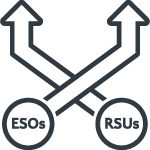Employee stock purchase plans (ESPP) are a convenient way to purchase company stock. In an ESPP’s simplest form, employees contribute money directly from their paychecks into an employer-offered plan.
At set intervals established by the company, money contributed is used to purchase shares of stock. Those shares are then deposited into an investment account on behalf of each employee who participates.
If you have an ESPP, the ease and convenience of using the plan might be a big benefit — but there are additional reasons you might want to take advantage.
The Benefits of an Employee Stock Purchase Plan
To attract employees to participate, many companies offer ESPP features like lookback provisions and discounts on the purchase price of the stock.
This means ESPPs aren’t just convenient. They can also be a great way to generate additional wealth with minimal risk for employees who immediately sell shares after they are purchased.
An immediate sale may generate a quick profit equal to the difference of the final sale price and the discounted price you purchased the shares at through the ESPP.
GET THIS GUIDE
When it comes to your finances, it's important to understand what you have, what you should consider, and how it can impact your personal goals. This guide is the best place to start.
What You Know Before Getting Started
Still, there are considerations to think through before actively participating in this kind of plan if your employer offers one. Contributing to an ESPP can impact your cash flow, your investment risk, your concentration of employer stock, and your other financial planning needs.
Before jumping in, make sure you fully understand your plan. Start by picking up a little knowledge about a few key terms associated with employee stock purchase plans.
Here is some information on eight key terms to get you started:
Offering Period
Set by the employer, the offering period is the length of time that you may be allowed to contribute after-tax money (usually directly from your paycheck) into your employee stock purchase plan. This money can then be used to purchase shares of company stock.
For a qualified ESPP, the maximum length of the offering period is 27 months. The exact length of an offering period can vary and be as long as that maximum or shorter, depending on the goals and objectives of the company.
Grant Date
The grant date is the first day of the offering period. For some plans, the price on the grant date matters as it may be used to determine what you pay when the ESPP buys shares of stock on your behalf.
Purchase Period
The purchase period is generally a subset of the offering period. At the end of a purchase period, your contributions to the plan are used to purchase shares of stock. These shares are usually deposited into a brokerage account for you.
To illustrate how an offering period and a purchase period co-exist, let’s assume that your company designs an ESPP with a 24-month offering period and a 6-month purchase period. During the offering period, the company will have four 6-month purchase periods. The final purchase coincides with the end of the offering period.
For each 6-month purchase period, the company will collect contributions to the ESPP. At the end of the six months, contributions will be used to purchase shares of stock on the purchase date (or exercise date).
Purchase Date
The purchase date, sometimes known as the exercise date of your ESPP, is when contributions are used to purchase shares of company stock. The purchase date typically occurs at the end of the purchase period, and always occurs at the end of the offering period.
Discount
To encourage participation in an ESPP, many companies chose to offer a discount to the purchase price of stock acquired via an ESPP. For a tax-qualified ESPP, the discount can be from 0-15%.
Lookback Provision
A lookback provision captures the stock price on the grant date of the ESPP. The grant date price and the price of the stock on the purchase date are then used to determine the actual purchase price of the stock.
For plans with longer offering periods, the lookback provision may be an even more appealing benefit of using an ESPP. If the price of the stock increases during the offering period, you’ll be able to continually buy shares at a lower grant date price for a more extended period.
Purchase Price
On the final day of the purchase period, or the final day of the offering period, shares of stock are purchased in an ESPP. The price paid for the stock is as follows:
- If no discount and no lookback provision is offered, shares of stock are purchased at stock price at the end of the purchase period.
- If a discount is offered, but there is no lookback provision, shares of stock are purchased at the stock price at the end of the purchase period, less the discount offered.
- If a discount and a lookback provision are both offered, shares of stock are purchased at the lower of the grant date stock price and the purchase date stock price, less the discount applied.
Qualifying Disposition (or Disqualifying Disposition)
If you participate in an ESPP, you will likely come across the terms qualifying disposition and disqualifying disposition. These terms speak to how profits (or losses) from an ESPP may be reported for income tax purposes.
A qualifying disposition can sometimes provide preferential tax treatment, which may be why people seek to achieve this (although it’s not always the best strategy). You will need to meet the following holding period requirements for your ESPP shares for a qualifying disposition:
- The final sale of the shares must occur as least 2 years from the grant date, AND
- The final sale of the shares must occur at least 1 year from the purchase date.
Anything that does not meet this standard is considered a disqualifying disposition. Note that what you do after your shares are purchased may have a meaningful impact on income tax, investment risk, and financial planning needs.
The actual tax implications of either scenario go beyond the scope of this article, but you may want to check out the following for more information on what kind of disposition makes the most sense for you:
- ESPP Tax Rules You Should Know – And How They Are Impacted by a Qualifying Disposition
- How a Qualifying Disposition Impacts Your ESPP
Your ESPP Can Be a Valuable Wealth-Building Tool — Just Make Sure You Understand It First!
The concept of purchasing shares at a discount to the current price, coupled with a lookback provision, can mean participating in an employee stock purchase plan is a great idea for you — and a great way to add to your wealth.
But as you can see, there are some nuances of ESPPs that can make things a little more complicated.
If you are offered an ESPP, one good place to start is by reading its plan document. This will detail exactly how your specific company plan works, what features it may offer, and explain if any of the other concepts detailed above apply to your ESPP.
Once you understand how your specific plan works, you can couple that information with your overall financial plan to determine if participation is a good idea, at what level, and what your strategy to buy, hold, and sell may be.










0 Comments